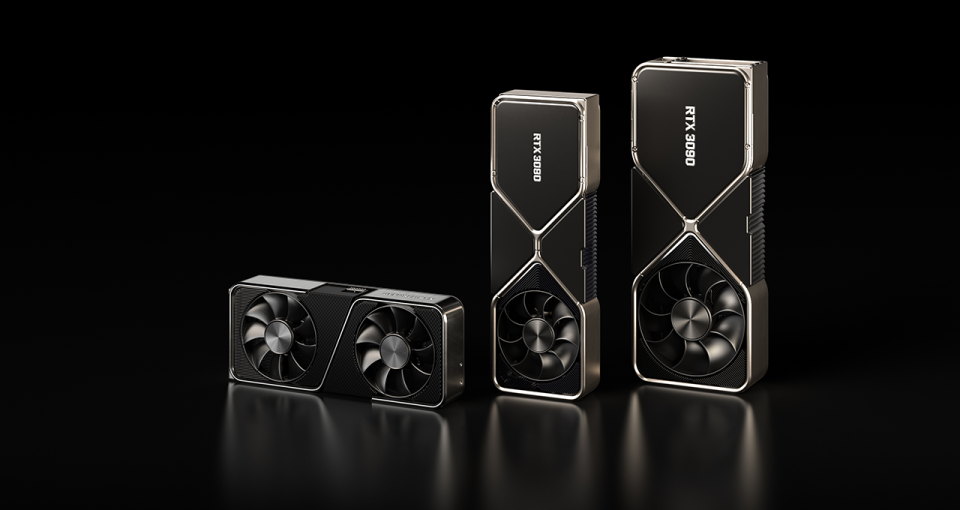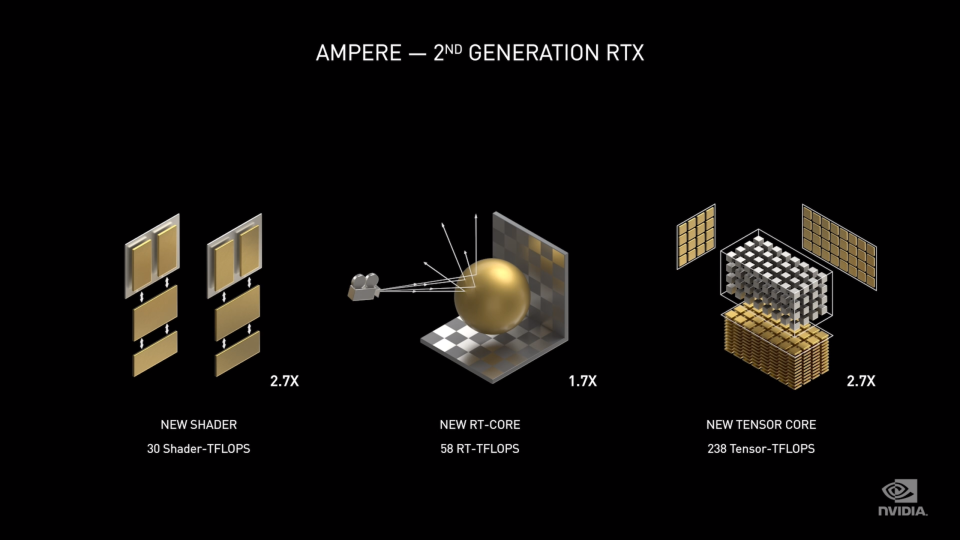Engadget has been testing and reviewing consumer tech since 2004. Our stories may include affiliate links; if you buy something through a link, we may earn a commission. Read more about how we evaluate products.
NVIDIA unveils the $699 GeForce RTX 3080, its first 'Ampere' GPU
And it also showed off the $499 RTX 3070.
NVIDIA’s latest 30 Series GPUs are officially here, after weeks of seemingly endless leaks. The company unveiled the RTX 3080 and RTX 3070 today, the first consumer offerings based on its new “Ampere” architecture. They promise significant performance improvements around real-time ray tracing, and they’ll include 10GB of GDDR6X RAM and 8GB of GDDR6 RAM, respectively. The flagship RTX 3080 will sell for $699, the same as the current 2080, while the mid-range RTX 3070 will go for $499. And if those aren’t powerful enough for you, the company also unveiled the RTX 3090, a massive $1,499 GPU for 8K gaming.
NVIDIA says the RTX 3080 is twice as fast as the 2080, while the 3070 is faster than the RTX 2080 Ti. We’re not sure how NVIDIA is measuring performance, but if the real-world numbers are anything close to the company’s estimates, high-end PC gaming just got a lot cheaper. (Time to start finding buyers for your old cards, folks.)

The reference version of the RTX 3080 will arrive with a dual-fan setup, with one fan exhausting air through the bracket, much like a blower cooler, and another flowing air over the card like a more contemporary cooling solution. Cards from third parties like EVGA and MSI will likely use more traditional two-and-three fan setups. The new GPUs will also feature 12-pin power connectors, instead of the larger dual 8-pin design from the last cards.
It’s been two years since NVIDIA debuted its RTX 2000-series GPUs, the first video cards with support for hardware accelerated ray tracing. Those GPUs, especially the top-end RTX 2080 Ti, finally delivered solid 4K gaming beyond 60FPS. But, as is often the case, it wasn’t too long before we started to see their limitations, especially when it came to real-time ray tracing performance in games like Control. Last year’s RTX “Super” cards were solid upgrades for NVIDIA’s mid-range lineup, but the 2080 Ti remained king of the hill. And despite costing over $1,000 and offering the best overall gaming performance we’d ever seen at the time, it was a titan that could still be humbled by ray tracing showcases like Minecraft RTX.

NVIDIA CEO Jensen Huang describes the new RTX Ampere architecture as a huge leap above the first generation. The RTX 3080 willl feature 30 shader teraflops instead of the 2080’s 11, and 58 RT TFLOPs, compared to 34. But Ampere's biggest leap is in its AI Tensor Cores, which clock in 238 tensor TFLOPs instead of just 89. Huang also said that the new architecture renders ray tracing more efficiently alongside normal rasterized rendering. The more a game relies on ray tracing, the bigger an improvement you'll see from an Ampere card.
NVIDIA also unveiled RTX IO, a new way to rapidly offload and decompress textures right from its GPUs. It pairs together with Microsoft’s DirectStorage for Windows to let RTX GPUs handle “dozens of CPU cores worth of work,” according to the company. The real takeaway? You can expect instant game loading on supported hardware, and none of the buffering issues you’d encounter on many open world games.
Both the 3080 and 3070 will be among the first GPUs to support HDMI 2.1. A common spec on modern high-end TVs, HDMI 2.1 allows for higher frame rates and resolutions than 2.0, such as 4K at 120 frames per second. The biggest feature for gamers, though, is built-in variable refresh rate support. This means that a supporting TV can behave similarly to a Freesync or G-Sync monitor, handling small variations to frame rate without visible stutter or torn frames.
The RTX 3080 will be available from September 17th, while the RTX 3070 launches October. The dramatically more exorbitant RTX 3090 will hit stores on September 24th. You can read about that monstrously powerful (and expensive) card here.

 Yahoo Finance
Yahoo Finance